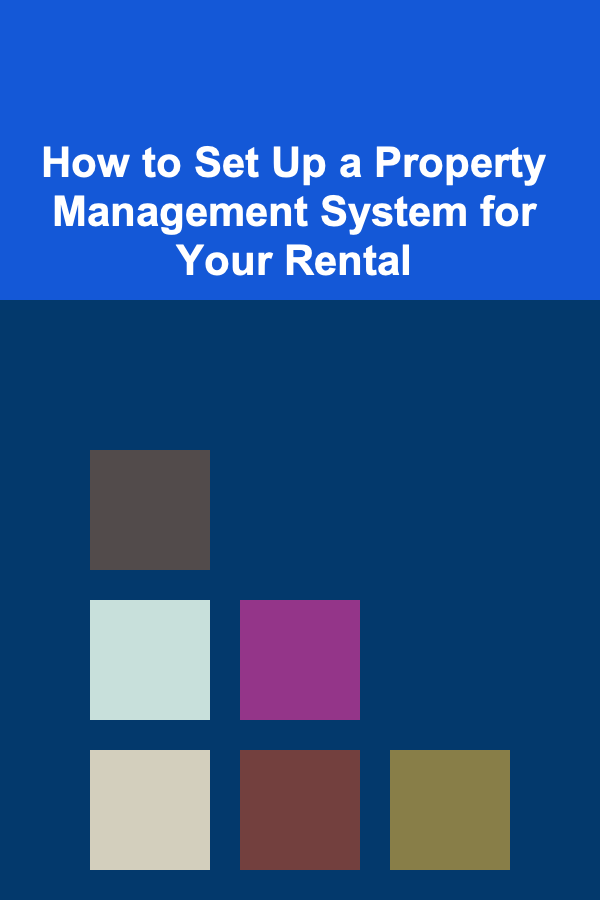
How to Set Up a Property Management System for Your Rental
ebook include PDF & Audio bundle (Micro Guide)
$12.99$8.99
Limited Time Offer! Order within the next:

Owning rental properties can be a rewarding investment, but managing them effectively is crucial to ensuring success. A well-organized property management system allows landlords to streamline operations, reduce errors, and enhance tenant satisfaction. Whether you own a single rental or an extensive portfolio, having a property management system (PMS) in place can help you stay on top of various tasks and responsibilities.
This article will guide you through the process of setting up a property management system for your rental properties. From understanding the core functions of property management to selecting the right tools, we will explore the key steps involved in creating an efficient and scalable system.
Understanding the Core Functions of Property Management
Before diving into the details of setting up a property management system, it is important to understand the core functions involved in managing rental properties. These tasks typically fall into the following categories:
1. Tenant Management
Tenant management involves handling tenant inquiries, lease agreements, and ensuring tenants comply with the lease terms. Key tasks include:
- Tenant screening: Evaluating potential tenants based on their creditworthiness, rental history, and ability to pay rent.
- Lease management: Drafting, signing, and enforcing lease agreements.
- Communication: Maintaining open lines of communication with tenants, addressing concerns, and managing requests.
- Rent collection: Ensuring timely rent payments and addressing late payments or missed rent.
2. Property Maintenance
Managing the physical condition of the property is essential to retaining tenants and maximizing the rental property's value. Tasks involved include:
- Routine maintenance: Handling routine repairs like plumbing, electrical work, and HVAC servicing.
- Emergency maintenance: Responding promptly to urgent repairs such as broken pipes or malfunctioning heating systems.
- Inspections: Conducting regular property inspections to identify and address any potential maintenance issues.
3. Financial Management
A crucial aspect of property management is handling the financial aspects of the rental business. This includes:
- Budgeting: Setting budgets for repairs, maintenance, and other expenses.
- Accounting: Keeping accurate records of income, expenses, and other financial transactions related to the property.
- Tax management: Ensuring proper documentation of expenses for tax purposes and claiming applicable deductions.
4. Legal Compliance
Staying compliant with local, state, and federal laws is vital to avoid legal disputes. Key legal considerations include:
- Evictions: Handling the eviction process in accordance with local laws.
- Fair housing laws: Ensuring the rental process adheres to discrimination-free housing practices.
- Health and safety regulations: Ensuring the property meets all safety standards, such as smoke detectors, fire extinguishers, and other compliance requirements.
Step 1: Assess Your Needs and Goals
The first step in setting up a property management system is to assess your needs and goals. Different rental properties have unique requirements, and understanding these will help you tailor your system to meet specific demands.
Here are a few key factors to consider when assessing your needs:
- Property type: Are you managing residential, commercial, or mixed-use properties? Different property types have different needs, such as maintenance schedules and tenant expectations.
- Portfolio size: Do you have a single property or multiple units? A larger portfolio may require a more sophisticated system to handle a higher volume of transactions.
- Management approach: Are you managing the property yourself, or are you planning to hire a property management company? If you're managing the property yourself, you'll need to invest in a system that helps you stay organized and efficient.
- Tenant demographics: Understanding your tenant demographic (e.g., young professionals, families, students) can help determine the best communication and payment methods.
Once you have a clear understanding of your needs, you can begin planning your property management system.
Step 2: Choose the Right Property Management Tools
An effective property management system requires the right tools to support various tasks. While some landlords prefer to manage everything manually (using paper files and spreadsheets), others opt for property management software to streamline processes.
Here's an overview of the tools you may need to set up your system:
1. Property Management Software
Property management software can automate and simplify many tasks, including rent collection, maintenance requests, and tenant communications. There are many property management software options available, ranging from basic tools for small landlords to comprehensive systems for large property managers. Some key features to look for include:
- Tenant and lease tracking: A system for storing tenant contact information, lease details, and payment history.
- Rent collection: Tools for accepting online payments and automating reminders for overdue rent.
- Maintenance tracking: Features that allow tenants to submit maintenance requests and track progress.
- Financial reporting: Automated reports to track income, expenses, and taxes.
- Document storage: A centralized location for storing lease agreements, invoices, and other important documents.
Popular property management software options include:
- Buildium: A cloud-based software that offers features for tenant management, rent collection, and financial reporting.
- AppFolio: A comprehensive property management solution that also includes marketing tools, tenant screening, and maintenance tracking.
- TenantCloud: A user-friendly platform for smaller landlords that offers rent collection, expense tracking, and maintenance management.
2. Accounting Software
Accurate financial records are crucial for managing rental properties effectively. Using accounting software like QuickBooks or Xero can help you keep track of income and expenses, generate tax reports, and monitor your profitability. These tools can integrate with your property management software to provide a holistic view of your financial situation.
3. Tenant Screening Tools
Tenant screening is a critical part of the leasing process. Using online tenant screening services allows you to evaluate potential tenants based on their credit history, rental history, and criminal background. Services such as TransUnion or RentPrep can provide detailed reports to help you make informed decisions.
4. Communication Tools
Maintaining good communication with your tenants is essential for a successful property management system. Consider using email, text messaging, or apps like Slack to stay in touch with tenants and keep them informed about important updates (e.g., maintenance schedules, lease renewals). Some property management software tools also include built-in communication features for streamlined messaging.
Step 3: Organize and Automate Processes
Once you have selected the right tools, the next step is to organize your processes and automate tasks wherever possible. Here's how you can streamline your property management operations:
1. Set Up a Centralized System for Tenant and Lease Information
Create a centralized system (preferably using property management software) to store all important tenant and lease information. This should include:
- Tenant contact details
- Lease start and end dates
- Rent amounts and payment history
- Security deposit details
- Maintenance requests and completed work
Having this information in one place allows you to quickly access tenant data, track lease renewals, and monitor rent payments.
2. Automate Rent Collection
One of the most time-consuming aspects of property management is rent collection. By automating the process, you can ensure that rent is paid on time without the need for manual reminders. Set up online payment systems that allow tenants to pay rent through secure portals or apps. These systems can send automatic payment reminders and late fees when necessary.
3. Streamline Maintenance Requests
Implement an online system for tenants to submit maintenance requests. Many property management software platforms include maintenance tracking features, which allow tenants to log issues and track progress. Automated reminders can be sent to property managers and maintenance staff to ensure issues are resolved promptly.
4. Create Standard Operating Procedures
Develop a set of standard operating procedures (SOPs) for key tasks such as tenant screening, lease renewals, maintenance, and rent collection. SOPs help ensure that processes are followed consistently, reducing errors and improving efficiency.
5. Monitor Financial Health
Set up automated financial reports that give you an overview of your rental income, expenses, and profitability. This allows you to identify any issues early and make informed decisions about your rental business. You should also track tax-related expenses to ensure you're maximizing deductions at the end of the year.
Step 4: Communicate with Tenants and Build Strong Relationships
An effective property management system isn't just about processes and tools; it's also about building positive relationships with tenants. Good communication and customer service can lead to long-term tenancies and reduce turnover.
1. Establish Clear Expectations
Make sure tenants are aware of the rules and expectations before they sign the lease. This includes rent payment schedules, maintenance procedures, and policies regarding noise, pets, and property alterations. Clear expectations reduce misunderstandings and conflicts.
2. Be Responsive to Tenant Needs
A property management system should include a communication strategy that allows you to quickly address tenant concerns. Ensure tenants can easily reach you for both routine and emergency matters. Respond promptly to maintenance requests and tenant inquiries.
3. Maintain Regular Inspections
Routine property inspections help identify potential issues before they become major problems. These inspections also allow you to check for lease violations (e.g., unauthorized pets or extra tenants). Keep tenants informed about inspections, and be respectful of their privacy.
4. Encourage Positive Feedback
Creating an environment where tenants feel comfortable providing feedback can help you improve your property management practices. Positive reviews and referrals from happy tenants can help you grow your rental business and maintain a good reputation.
Step 5: Stay Compliant with Laws and Regulations
One of the most important aspects of property management is ensuring legal compliance. Each state, and often each city, has specific rental laws regarding security deposits, eviction procedures, tenant rights, and fair housing practices.
Make sure your property management system accounts for these legal requirements. Keep up-to-date with any changes in local and federal laws that could affect your rental properties. This might include rent control laws, tenant protection laws, and building safety codes.
Consider consulting with a real estate attorney or property management professional to ensure your system is legally sound.
Conclusion
Setting up a property management system is essential for the smooth operation of your rental business. By carefully selecting the right tools, automating key processes, organizing tenant and lease information, and building strong relationships with tenants, you can streamline operations and ensure the long-term success of your rental properties. Whether you're managing a single property or an extensive portfolio, a well-designed property management system will help you stay organized, reduce stress, and maximize your rental income.
Reading More From Our Other Websites
- [Organization Tip 101] How to Use Binders to Organize Your Favorite Recipes
- [Home Cleaning 101] How to Clean Your Home After a Home Renovation
- [Organization Tip 101] How to Categorize Household Items for Efficient Inventory Management
- [Home Security 101] How to Choose the Best Home Security Camera System
- [Home Holiday Decoration 101] How to Use Candles to Add a Cozy Touch to Your Holiday Decor
- [Metal Stamping Tip 101] Choosing the Right Materials: Metals That Excel in Electronic Stamping Applications
- [Home Rental Property 101] How to Keep Your Home Rental Property Secure and Safe for Tenants
- [Personal Care Tips 101] How to Choose Soap for Maintaining Soft, Smooth Skin
- [Organization Tip 101] Step-by-Step Guide to Sealing Your Driveway Like a Pro
- [Screen Printing Tip 101] Best Ultra‑Fine Mesh Selections to Achieve Photographic Detail in Screen Printing

How to Build a Spring Cleaning Checklist for Your Closets
Read More
How to Create a Welcoming Entrance for Home Staging
Read More
How to Get Better at Abstract Board Games
Read More
How to Make Money Online as a Coach: 10 Actionable Ideas
Read More
How to Use Baking Soda and Vinegar for Appliance Cleaning
Read More
How to Master AutoCAD for Mechanical Drafting
Read MoreOther Products

How to Build a Spring Cleaning Checklist for Your Closets
Read More
How to Create a Welcoming Entrance for Home Staging
Read More
How to Get Better at Abstract Board Games
Read More
How to Make Money Online as a Coach: 10 Actionable Ideas
Read More
How to Use Baking Soda and Vinegar for Appliance Cleaning
Read More